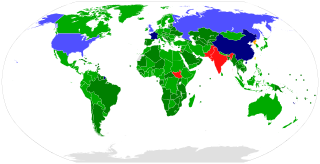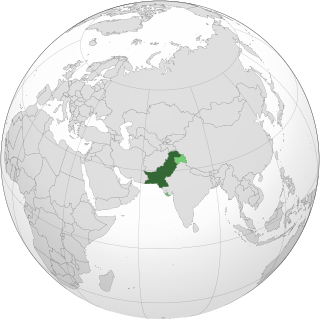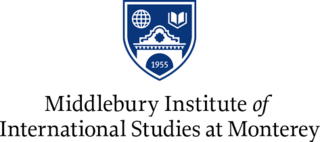Related Research Articles

The Treaty on the Non-Proliferation of Nuclear Weapons, commonly known as the Non-Proliferation Treaty or NPT, is an international treaty whose objective is to prevent the spread of nuclear weapons and weapons technology, to promote cooperation in the peaceful uses of nuclear energy, and to further the goal of achieving nuclear disarmament and general and complete disarmament. Between 1965 and 1968, the treaty was negotiated by the Eighteen Nation Committee on Disarmament, a United Nations-sponsored organization based in Geneva, Switzerland.

Nuclear proliferation is the spread of nuclear weapons, fissionable material, and weapons-applicable nuclear technology and information to nations not recognized as "Nuclear Weapon States" by the Treaty on the Non-Proliferation of Nuclear Weapons, commonly known as the Non-Proliferation Treaty or NPT. Proliferation has been opposed by many nations with and without nuclear weapons, as governments fear that more countries with nuclear weapons will increase the possibility of nuclear warfare, de-stabilize international or regional relations, or infringe upon the national sovereignty of nation states.

Nuclear disarmament is the act of reducing or eliminating nuclear weapons. Its end state can also be a nuclear-weapons-free world, in which nuclear weapons are completely eliminated. The term denuclearization is also used to describe the process leading to complete nuclear disarmament.

North Korea has a military nuclear weapons program and, as of early 2020, is estimated to have an arsenal of approximately 30 to 40 nuclear weapons and sufficient production of fissile material for six to seven nuclear weapons per year. North Korea has also stockpiled a significant quantity of chemical and biological weapons. In 2003, North Korea withdrew from the Treaty on the Non-Proliferation of Nuclear Weapons (NPT). Since 2006, the country has been conducting a series of six nuclear tests at increasing levels of expertise, prompting the imposition of sanctions.

The People's Republic of China has developed and possesses weapons of mass destruction, including chemical and nuclear weapons. The first of China's nuclear weapons tests took place in 1964, and its first hydrogen bomb test occurred in 1967. Tests continued until 1996, when China signed the Comprehensive Test Ban Treaty (CTBT). China has acceded to the Biological and Toxin Weapons Convention (BWC) in 1984 and ratified the Chemical Weapons Convention (CWC) in 1997.

Pakistan is one of nine states to possess nuclear weapons. Pakistan began development of nuclear weapons in January 1972 under Prime Minister Zulfikar Ali Bhutto, who delegated the program to the Chairman of the Pakistan Atomic Energy Commission (PAEC) Munir Ahmad Khan with a commitment to having the device ready by the end of 1976. Since PAEC, which consisted of over twenty laboratories and projects under reactor physicist Munir Ahmad Khan, was falling behind schedule and having considerable difficulty producing fissile material, Abdul Qadeer Khan, a metallurgist working on centrifuge enrichment for Urenco, joined the program at the behest of the Bhutto administration by the end of 1974. As pointed out by Houston Wood, "The most difficult step in building a nuclear weapon is the production of fissile material"; as such, this work in producing fissile material as head of the Kahuta Project was pivotal to Pakistan developing the capability to detonate a nuclear weapon by the end of 1984.

The Missile Technology Control Regime (MTCR) is a multilateral export control regime. It is an informal political understanding among 35 member states that seek to limit the proliferation of missiles and missile technology. The regime was formed in 1987 by the G-7 industrialized countries. The MTCR seeks to limit the risks of proliferation of weapons of mass destruction (WMD) by controlling exports of goods and technologies that could make a contribution to delivery systems for such weapons. In this context, the MTCR places particular focus on rockets and unmanned aerial vehicles capable of delivering a payload of at least 500 kg (1,100 lb) to a range of at least 300 km and on equipment, software, and technology for such systems.

The Japanese program to develop nuclear weapons was conducted during World War II. Like the German nuclear weapons program, it suffered from an array of problems, and was ultimately unable to progress beyond the laboratory stage before the atomic bombings of Hiroshima and Nagasaki and the Japanese surrender in August 1945.

South Korea has the raw materials and equipment to produce a nuclear weapon but has not opted to make one. In August 2004, South Korea revealed the extent of its highly secretive and sensitive nuclear research programs to the International Atomic Energy Agency (IAEA), including some experiments which were conducted without the obligatory reporting to the IAEA called for by South Korea's safeguards agreement. The failure to report was reported by the IAEA Secretariat to the IAEA Board of Governors; however, the IAEA Board of Governors decided to not make a formal finding of noncompliance. However, South Korea has continued on a stated policy of non-proliferation of nuclear weapons and has adopted a policy to maintain a nuclear-free Korean Peninsula.

Iran is not known to currently possess weapons of mass destruction (WMD) and has signed treaties repudiating the possession of WMDs including the Biological Weapons Convention, the Chemical Weapons Convention, and the Non-Proliferation Treaty (NPT). Iran has first-hand knowledge of WMD effects—over 100,000 Iranian troops and civilians were victims of chemical weapons during the 1980s Iran–Iraq War.

The Middlebury Institute of International Studies at Monterey (MIIS), formerly known as the Monterey Institute of International Studies, is an American graduate school of Middlebury College, a private college in Middlebury, Vermont.

Saudi Arabia is not known to have a nuclear weapons program. From an official and public standpoint, Saudi Arabia has been an opponent of nuclear weapons in the Middle East, having signed the Treaty on the Non-Proliferation of Nuclear Weapons, and is a member of the coalition of countries demanding a Nuclear-weapon-free zone in the Middle East. Studies of nuclear proliferation have not identified Saudi Arabia as a country of concern. Nuclear technology company IP3 International was formed in June 2016 to transfer nuclear technology from the United States to Saudi Arabia.

The State of Israel is widely believed to possess nuclear weapons. Estimates of Israel's stockpile range between 80 and 400 nuclear warheads, and the country is believed to possess the ability to deliver them in several methods, including by aircraft, as submarine-launched cruise missiles, and via the Jericho series of intermediate to intercontinental range ballistic missiles. Its first deliverable nuclear weapon is thought to have been completed in late 1966 or early 1967; which would make it the sixth country in the world to have developed them.
This timeline of nuclear weapons development is a chronological catalog of the evolution of nuclear weapons rooting from the development of the science surrounding nuclear fission and nuclear fusion. In addition to the scientific advancements, this timeline also includes several political events relating to the development of nuclear weapons. The availability of intelligence on recent advancements in nuclear weapons of several major countries is limited because of the classification of technical knowledge of nuclear weapons development.
This is a comparison list of intercontinental ballistic missiles developed by various countries.
The Hwasong-13, also known as Rodong-C or KN-08 under the U.S. naming convention, is a road-mobile intercontinental ballistic missile believed to be under development by North Korea. The changes shown in the mock-up displayed in October 2015 indicated a change from a three to two-stage design.
The Kangson enrichment site is the name given to a suspected uranium enrichment site located in Chollima-guyok, just outside of Pyongyang, North Korea, along the Pyongyang-Nampo Expressway.
The Chinese biological weapons program is a biological weapons program reported to have been active in the 1980s, and suspected by some governments and security analysts to remain covertly active. China is currently a signatory of the Biological Weapons Convention (BWC) and Chinese officials have stated that China has never engaged in biological activities with offensive military applications. China was reported to have had an active biological weapons program in the 1980s. Members of the US intelligence community heavily suspect that the state of China had, as of 2015, at least 42 facilities that may be involved in research, development, production, or testing of biological agents.
References
- ↑ "Nonproliferation & Terrorism Studies Faculty" . Retrieved June 11, 2015.
- ↑ Lewis, Jeffrey. "Mike Pompeo Is Bragging About an Imaginary Trump Legacy". Foreign Policy. Retrieved 2021-02-08.
- ↑ "About Us – armscontrolwonk" . Retrieved June 11, 2015.
- ↑ "Dr. Jeffrey Lewis" . Retrieved June 11, 2015.
- ↑ "American Strategy Program – Nuclear Strategy & Nonproliferation Initiative". Archived from the original on February 23, 2009. Retrieved June 11, 2015.
- ↑ "Belfer Center Home > Experts > Jeffrey G. Lewis" . Retrieved June 11, 2015.
- ↑ "Jeffrey Lewis – Director – East Asia Nonproliferation Program" . Retrieved June 11, 2015.
- ↑ Hanham, Melissa (February 4, 2015). "CNS Produces Workshop on Open Source Analysis for UC Berkeley" . Retrieved June 11, 2015.
- ↑ "Author – Melissa Hanham" . Retrieved June 11, 2015.
- ↑ Hanham, Melissa (March 4, 2015). "Hello, World!" . Retrieved June 11, 2015.
- ↑ "Jeffrey Lewis – Stanford CISAC" . Retrieved June 11, 2015.
- ↑ Sang-hun, Choe; Gladstone, Rick (January 25, 2013). "North Korea turns its ire on South Korea". The New York Times. Retrieved June 12, 2015.
- ↑ Gladstone, Rick; Mullany, Gerry (August 7, 2013). "Study Suggests North Korea Is Doubling Area Devoted to Uranium Enrichment". The New York Times. Retrieved June 12, 2015.
- ↑ Fisher, Max (February 12, 2013). "Why it's so hard to tell if North Korea used a plutonium or (much scarier) uranium bomb". The Washington Post. Retrieved June 12, 2015.
- ↑ "Q&A: Uranium enrichment". BBC News. September 1, 2006. Retrieved June 12, 2015.
- ↑ "North Korea's Yongbyon reactor 'nearing operation'". BBC News. September 12, 2013. Retrieved June 12, 2015.
- ↑ "N Korea 'develops Russian cruise missile'". BBC News. June 17, 2014. Retrieved June 12, 2015.
- ↑ Fifield, Anna (May 20, 2015). "North Korea says it has technology to make mini nuclear warheads". The Washington Post. Retrieved June 12, 2015.
- ↑ "North Korea missile strike remains a real threat". The Washington Times .
- ↑ Brumfiel, Geoff (April 27, 2017). "The North Korean Electromagnetic Pulse Threat, Or Lack Thereof". NPR. Retrieved May 18, 2017.
- ↑ Lewis, Jeffrey (May 26, 2015). "Great, now China's got multiple warhead missiles?". Foreign Policy.com. Retrieved June 18, 2015.
- ↑ Lewis, Jeffrey; Stein, Aaron (May 19, 2015). "China MIRVs some missiles". armscontrolwonk.com. Retrieved June 18, 2015.
- ↑ Sanger, David; Broad, William (May 16, 2015). "China Making Some Missiles More Powerful". The New York Times. Retrieved June 12, 2015.
- ↑ Marcus, Jonathan (April 20, 2012). "Will India's missile test trigger arms race with China?". BBC News. Retrieved June 12, 2015.
- ↑ Lewis, Jeffrey (September 4, 2014). "Crashing Glider, Hidden Hotspring". armscontrolwonk.com. Retrieved June 18, 2015.
- ↑ "A Place for One's Mat: China's Space Program, 1956–2003".
- ↑ "Author – Jeffrey Lewis" . Retrieved June 11, 2015.